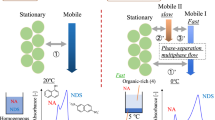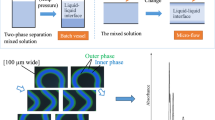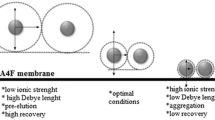Abstract
We developed a new type of HPLC system that uses phase-separation multiphase flow as an eluent. A commercially available HPLC system with a packed separation column filled with octadecyl-modified silica (ODS) particles was used. First, as preliminary experiments, 25 kinds of mixed solutions of water/acetonitrile/ethyl acetate and water/acetonitrile were supplied to the system to act as eluents at 20 °C. 2,6-Naphthalenedisulfonic acid (NDS) and 1-naphthol (NA) mixture was used as a model and mixed analyte was injected into the system. Roughly speaking, they were not separated in organic solvent-rich eluents and well separated in water-rich eluents, in which NDS eluted faster than NA. This means that HPLC worked under a reverse-phase mode for separation at 20 °C. Next, the separation of the mixed analyte was examined on HPLC at 5 °C, and then after judging the results, four kinds of ternary mixed solutions were in detail as eluents on HPLC at 20 °C and 5 °C. Based on their volume ratio, the ternary mixed solutions acted as a two-phase separation mixed solution, leading to a phase-separation multiphase flow. Consequently, the solutions flowed homogeneously and heterogeneously in the column at 20 °C and 5 °C, respectively. For example, the ternary mixed solutions containing water/acetonitrile/ethyl acetate at volume ratios of 20:60:20 (organic solvent-rich) and 70:23:7 (water-rich) were delivered into the system as eluents at 20 °C and 5 °C. In the organic solvent-rich eluent, the mixture of NDS and NA was not separated at 20 °C but was separated at 5 °C, the elution of NA being faster than the one of NDS (phase-separation mode). In the water-rich eluent, the mixture of analytes was separated at both 20 °C and 5 °C, the elution of NDS being faster than the one of NA. The separation at 5 °C was more effective than at 20 °C (reverse-phase mode and phase-separation mode). This separation performance and elution order can be attributed to the phase-separation multiphase flow at 5 °C.
Graphical abstract









Similar content being viewed by others
Data availability
The separation mode gave a useful clue to create novel separation behavior in HPLC system.
References
A. Oztekin, B.R. Seymour, E. Varley, Eur. J. Appl. Math. 11, 529 (2000). https://doi.org/10.1017/S0956792500004289
N. Haque, A. Singh, U.K. Saha, J. Energy. Resour. Technol. (2022). https://doi.org/10.1115/14050958
L. Lei, Y. Zhao, W. Chen, H. Li, X. Wang, J. Zhang, Energies 14, 1341 (2021). https://doi.org/10.3390/en14051341
Y. Lin, P. Skjente, A. Carison, Int. J. Multiph. Flow 45, 1 (2012). https://doi.org/10.1016/j.ijmultiphaseflow.2012.04.002
S. Xue, F. Zhou, T. Zhao, H. Zhao, X. Wang, L. Chen, J.-P. Li, S.-Z. Luo, Nat. Commun. 13, 1112 (2022)
C. Rigoni, G. Beaune, B. Harnist, F. Sohrabi, J.V.I. Timonen, Commun. Mater. 3, 26 (2022)
M. Murakami, N. Jinno, M. Hashimoto, K. Tsukagoshi, Anal. Sci. 27, 793 (2011). https://doi.org/10.2116/analsci.27.793
N. Jinno, M. Murakami, K. Mizohata, M. Hashimoto, K. Tsukagoshi, Analyst 136, 927 (2011). https://doi.org/10.1039/C0AN00820F
K. Tsukagoshi, J. Flow Injection Anal. 32, 89 (2015). https://doi.org/10.24688/jfia.32.2_89
K. Tsukagoshi, Anal. Sci. 30, 65 (2014). https://doi.org/10.2116/analsci.30.65
K. Tsukagoshi, Bunseki-Kagaku (review) 71, 25 (2022)
S.C. Lam, R.E. Sanz, P.R. Haddad, B. Paull, Analyst 144, 3464 (2019). https://doi.org/10.1039/C9AN00329K
S. Fujinaga, M. Hashimoto, K. Tsukagoshi, J. Mizushima, Anal. Sci. 32, 455 (2016). https://doi.org/10.2116/analsci.32.455
Y. Takahashi, K. Nishimura, K. Tsukagoshi, K. Tsuchiya, K. Hirota, K. Yamashita, M. Murata, Anal. Sci. 37, 1373 (2021). https://doi.org/10.2116/analsci.21P009
K. Horikawa, S. Kinoshita, K. Tsuchiya, K. Tsukagoshi, Anal. Sci. 38, 731 (2022). https://doi.org/10.1007/s44211-022-00127-1
S. Fujinaga, M. Hashimito, K. Tsukagoshi, J. Liq. Chromatogr. Relat. Technol. 38, 600 (2015)
L.R. Snyder, J. Chromatogr. Sci. 16, 223 (1978). https://doi.org/10.1093/chromsci/16.6.223
C.F. Poole, S.N. Atapattu, J. Chromatogr. A. 1626, 461427 (2020). https://doi.org/10.1016/j.chroma.2020.461427
V. Alwera, S. Sehlangia, S. Alwera Shiv, Biomed. Chromatogr. 34, 4954 (2020). https://doi.org/10.1002/bmc.4954
Acknowledgements
The authors are grateful to Dr. H. Sakamaki and Mr. Y. Obata (Chemicals Evaluation and Research Institute, Japan) for useful discussions. The authors would like to thank Mr. K. Horikawa for collaboration on the early stages of this work. This work was supported by a Grant-in-Aid for Scientific Research (B) from the Ministry of Education, Culture, Sports, Science, and Technology, Japan (MEXT) (No. 17H03083).
Author information
Authors and Affiliations
Corresponding author
Rights and permissions
Springer Nature or its licensor (e.g. a society or other partner) holds exclusive rights to this article under a publishing agreement with the author(s) or other rightsholder(s); author self-archiving of the accepted manuscript version of this article is solely governed by the terms of such publishing agreement and applicable law.
About this article
Cite this article
Jallas, N., Ishikawa, D., Katayama, T. et al. Development of HPLC system that uses phase-separation multiphase flow as an eluent. ANAL. SCI. 39, 883–892 (2023). https://doi.org/10.1007/s44211-023-00290-z
Received:
Accepted:
Published:
Issue Date:
DOI: https://doi.org/10.1007/s44211-023-00290-z




